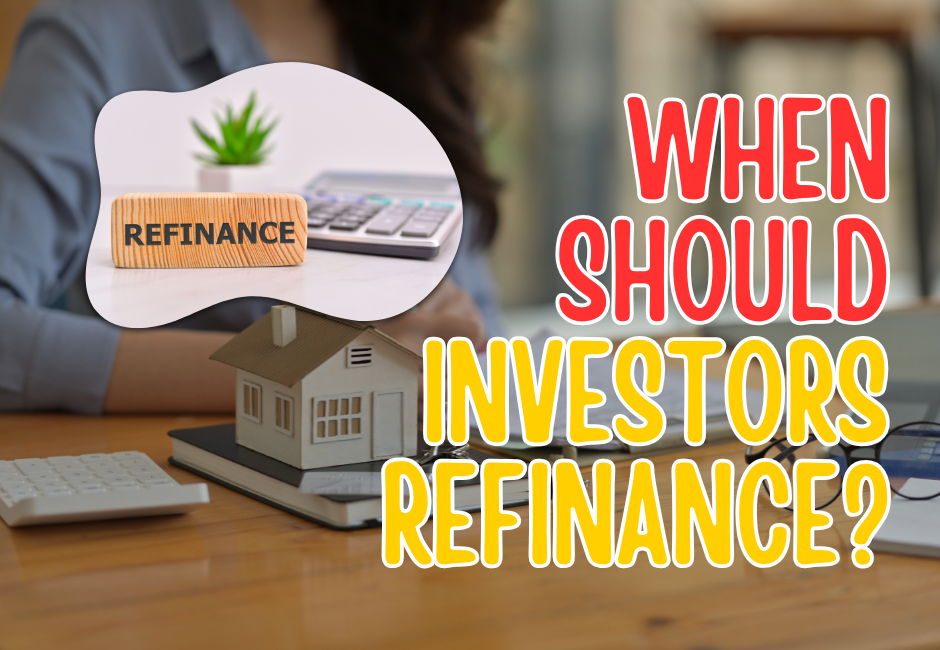
Refinancing for Property Investors: When Does It Make Financial Sense?
Introduction
For property investors, refinancing can be a powerful lever to reduce borrowing costs, unlock equity, and improve cash flow. But while the potential benefits are enticing, refinancing is not always the right financial move. Beyond chasing a lower interest rate, investors need to weigh factors like exit fees, break costs, loan terms, and the long-term impact on their portfolio.
A data-driven approach is essential. By comparing potential savings against the real costs involved, investors can decide whether refinancing aligns with their strategy. This guide breaks down the relationship between interest rates and refinancing costs, shares real-life case studies of successful refinancing, and outlines a clear step-by-step process for making smart refinancing decisions.
Interest Rates vs. Cost of Refinancing: Crunching the Numbers
Why Interest Rates Matter
Interest rates are the headline driver behind most refinancing decisions. When market rates fall, refinancing into a lower-rate loan can save thousands in interest over the life of the loan. But rates alone don’t tell the full story—investors must look at the total financial picture.
The Break-Even Point: Your Key Metric
The break-even point tells you how long it will take for your refinancing savings to cover the upfront costs of switching loans. Once you pass that point, the savings flow straight to your bottom line.
Example calculation:
- Current loan: $500,000 at 5.5%, 25 years remaining
- New loan: $500,000 at 4.5%, 25 years remaining
- Monthly repayment savings: $315
- Refinancing costs (exit fees, new loan fees): $3,500
- Break-even: $3,500 ÷ $315 = ~11 months
In this scenario, refinancing makes sense if you plan to hold the loan for more than 11 months.
Hidden Costs to Watch For
Refinancing costs aren’t always obvious. Consider these:
- Exit and break fees — Especially on fixed-rate loans, break costs can be hefty.
- Lenders Mortgage Insurance (LMI) — If your loan-to-value ratio (LVR) is above 80%, you may trigger new LMI costs.
- Establishment fees — Loan application, valuation, and settlement fees can chip away at savings.
- Loss of features — Some cheaper loans cut valuable features like offset accounts or redraw facilities.
The bottom line: weigh these costs against your long-term gains.
Case Studies: How Investors Used Refinancing to Their Advantage
Case Study 1: Boosting Cash Flow with Lower Rates
Investor profile:
Sarah owns a $450,000 mortgage on an investment unit at 6.2%, with monthly repayments of $2,754.
Refinancing move:
Sarah refinanced at 4.2%, dropping repayments to $2,200—saving $554 per month.
Outcome:
She broke even on the refinancing costs within 9 months and used the extra cash flow to build a deposit for her next investment.
Case Study 2: Tapping Equity for Portfolio Growth
Investor profile:
James and Lisa own a duplex worth $800,000, with a $450,000 mortgage.
Refinancing move:
They refinanced to access $150,000 in equity, raising the total loan to $600,000 but lowering their rate by 0.8%.
Outcome:
The equity funded a second property purchase, and the rental income from that new asset helped cover their increased loan repayments.
Case Study 3: Consolidating Debt to Reduce Stress
Investor profile:
Michael had a $350,000 investment loan and a $50,000 personal loan at 10%.
Refinancing move:
He consolidated both into a $400,000 mortgage at 4.8%.
Outcome:
Michael significantly reduced his monthly repayments, stabilising his cash flow and freeing up funds for future investments.
Step-by-Step Guide to Refinancing Strategically
Step 1: Review Your Current Loan and Goals
- What’s your current interest rate and balance?
- Are you aiming to lower repayments, release equity, or restructure your portfolio?
- Are there any break costs or penalties on your current loan?
Step 2: Compare Refinancing Options
Look beyond rates:
- Interest rate — Focus on long-term savings, not just short-term discounts.
- Loan features — Offset accounts, redraw, extra repayments.
- Upfront and ongoing costs — Exit fees, LMI, and establishment costs.
Step 3: Use a Refinancing Calculator
Many lenders offer online tools to help calculate potential savings, repayments, and break-even timelines. This gives you a data-backed foundation for your decision.
Step 4: Speak to a Mortgage Broker
A good broker can:
- Identify lenders offering the best deals for investors.
- Navigate complex borrowing structures.
- Negotiate lower rates or better loan features on your behalf.
Step 5: Apply for the New Loan and Finalise the Switch
Be prepared to:
- Submit updated financial documents.
- Complete a property valuation.
- Pay any exit and establishment fees.
- Set up your new loan account and repayments.
Step 6: Monitor and Review Regularly
Refinancing isn’t a one-off event. Review your loan every few years to ensure you’re still on the best deal—especially when market rates shift.
When Does Refinancing Make Sense?
✔ You can reduce your interest rate by at least 0.5–1% after accounting for costs.
✔ You plan to hold the property long enough to reach the break-even point.
✔ You want to access equity to expand your portfolio.
✔ You want to consolidate high-interest debt into your mortgage.
Conclusion
Refinancing can be an excellent strategy for investors to lower borrowing costs, improve cash flow, unlock equity, or consolidate debt—but only when approached carefully. The key is to run the numbers, weigh the costs against the savings, and align refinancing decisions with your investment goals.
By calculating the break-even point, comparing lender options, and learning from other investors’ success stories, you can make confident, strategic refinancing moves that strengthen your portfolio for the long term.




